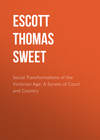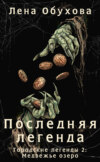Buch lesen: «Social Transformations of the Victorian Age: A Survey of Court and Country»
PREFACE
It may be well very briefly to explain the relation in which the present work stands to a survey, not a history, of modern England undertaken by the same author some years ago. That earlier work was originally published by Messrs Cassell and Co. in two volumes. It was reprinted, first by them, secondly by Messrs Chapman and Hall, in a single volume. Into that re-issue of his England: Its People, Polity, and Pursuits (the labour of revision being much lightened by the obliging help of Mr Francis Drummond), the author introduced certain references to social or legislative changes effected since the original edition of the work appeared. Without organic disturbance of its plan, and risk of consequent confusion to the reader, it would have been impossible to bring down that book to the year 1897. The writer does not in the following pages pre-suppose any knowledge of his former book on the part of the readers of his present one. He has, however, held himself absolved from the duty of repeating in this book minute accounts of institutions fully described in its predecessor. Such repetition seemed the more undesirable because the earlier book is still in wide circulation here; while it has been translated into several European languages, and has been adopted as a text book in the higher grade State schools of Germany,1 and of other countries. The method of workmanship adopted in Social Transformations of the Victorian Age is identical with that pursued in the case of England, Etc.
This new book being, like its predecessor, not a history, but a series of different views from a common standpoint, the sketches of national life and character as well as of national institutions at work, have in all cases been made from personal observation; supplemented by the assistance of the highest experts in their different departments to whom the writer had access. Often, he is glad to say, the same private friends who helped him in the seventies have been able to renew that help in the nineties. Thus, Sir Charles Dilke, Sir Robert Herbert, Mr Mundella, Mr Archibald Milman of the House of Commons, and Mr Albert Pell have generally and specifically repeated the assistance lent to him twenty years earlier. In most cases it is hoped the assistance given has been acknowledged in its proper place. In many cases the advantages of this service extend beyond any particular passage. In all which relates to the new schemes of local government the writer is particularly indebted to Mr Henry Chaplin or members of his staff; to Sir Henry Fowler; to Sir Charles Dilke; to the Rev. J. Charles Cox, LL.D., of Holdenby, as in ecclesiastical matters to the Rev. A. L. Foulkes of Steventon, and to the Rev. H. W. Tucker, D.D., of the Society for the Propagation of the Gospel. In references to certain phases of social history, especially about the early railway period, he has learned much from Lord Carlingford, Mr Markham Spofforth, Mr J. C. Parkinson, and from Sir W. H. Russell. And finally he would specially thank several gentlemen of the Education Department, as well as the Vice-President himself, Sir John Gorst. It is hoped that, as in the case of the writer’s England, so in that of his new book, the collaboration of those who are, in their different provinces, experts, has ensured a more uniform accuracy than in a volume dealing with such a variety of subjects would otherwise have been attainable.
T. H. S. E.
CHAPTER I
TWO EPOCHS OF VICTORIAN SOCIETY CONTRASTED
Difference between English society in the earlier and later years of the Queen’s reign illustrated from the composition of Hyde Park crowds, first, when the Park was a playground for the Royal children, and a parade ground for social celebrities, secondly, as it has become since. Different generations of Victorian Royalty. Great noblemen, Lord Lansdowne, Lord Eglinton, Lord Shrewsbury, Lord Shaftesbury, The Duke of Wellington. Statesmen, Earl Grey, Sir Robert Peel. Other celebrities, social, or intellectual, or literary. The dandies, some of them sketched by Thackeray, Morgan O’Connell, the original of ‘The O’Mulligan,’ Alfred Montgomery, Alexis Soyer, Lord Adolphus Fitzclarence, 1848-51. Tall forms of Thackeray and Jacob Omnium overtopping the crowd. The editor of the Times, J. T. Delane, on horseback. The absence in later days of eminent individuals like these; the old editor and the new. A. W. Kinglake among the last riders in Hyde Park of veterans who write. Commerce in the Park and in society represented by ‘King’ Hudson before and after his fall. Lord Tollemache, of Peckforton, the last of great nobles familiar to English crowds.
As it is to-day, so, during the earlier years of the present reign, both before and after the Great Exhibition of 1851, Hyde Park was the social parade ground, not only of the capital, but of the Kingdom. Then, as now, its human panorama was the representative reflection of the social conditions not less than of the typical personages of the era.
Throughout the later forties or the fifties, the loungers from the provinces were certainly not less numerous in Hyde Park than to-day. Foreign visitors were beginning to be a feature in the Metropolitan summer. But the scale on which the London season half a century ago was observed was so small as to resemble but faintly its successors known to the present generation. Society scarcely exceeded the dimensions of a family party. Hyde Park itself seemed a Royal pleasure ground first, a popular resort afterwards, to which strangers were, as to the Park at Windsor, admitted by favour of the first Constitutional Sovereign, to behold the pastimes of the rising generations of Royalty. The little boy and girl, steering their ponies through the maze of carriages, horses, or pedestrians, were the Prince of Wales and the Princess Royal. Observers noted with appreciative criticism the progress made from day to day by the young riders. Other of the Queen’s descendants of age still more tender, followed with their parents in an open carriage, the exact build of which had been introduced by the Prince Consort, and were manifestly being instructed by their father or mother in the art of acknowledging gracefully the respectful salutations of spectators.
The company crowding the Park, and most familiar to London onlookers differed from the crowds of succeeding decades, first, in the monotony of its composition, secondly, in the commanding ascendancy of some among the individuals whom it numbered. This was a kind of feudal age in our social development. The monarch was surrounded by subjects, the splendour of whose station, or the lustre of whose endowments caused them to shine forth in their exalted firmament, with a light of their own not reflected by, though comparable with, that of Royalty itself. Two noblemen, during the first quarter of a century of the Queen’s reign, one Scotch, the other English, seemed to eclipse the rest of the peerage. The Earl of Eglinton, of the period now referred to, was famous, even among Englishmen, from the tournament held some years earlier in 1839 at Eglinton Castle, and described by Mr Disraeli in his last novel, Endymion. The lady who had been the Queen of Beauty upon the occasion, the Duchess of Somerset, was then a synonym for all which women envy or men admire. When she appeared in Hyde Park, the crowd gazed at her carriage with the awed admiration that they bestowed on those born to thrones. North of the Tweed, Lord Eglinton summed up to his adoring countrymen, in his own person, all the influence, the dignity, the splendour, the power, and all the other attributes of greatness with which the principle of birth could be endowed. What Lord Eglinton was in Scotland, or to the natives of Scotland in London, Lord Lansdowne2 had long been to all classes of Englishmen, not more in his native county than in London. Here, during the earlier Victorian seasons, he was conspicuous in Hyde Park, generally by his perfect demeanour of high breeding, specially by this blue coat and voluminous white neck investment. After him, slowly riding on a horse whose familiarity can best be expressed to readers of to-day by comparing it with that sometime attained by the white cob of Mr Lowe, Lord Sherbrooke, there appeared, in the blue coat and white trousers of the old régime, the figure before whom all heads instinctively uncovered, the great Duke of Wellington. On horseback, also, were two other men, second only in eminence to the Duke himself, Lord Palmerston, and Sir Robert Peel. The first still wore his years lightly and was as much at home in the saddle as in the House of Commons. Sir Robert Peel, still a remarkably handsome man, had the enthusiasm of the equestrian. Those who can recall the loose connection between Bishop Samuel Wilberforce and the steed which he bestrode, can form an idea of the ‘seat’ of the great Sir Robert.
Next to the representatives of the reigning family and to the statesmen who were the props of the young Queen’s throne, the attention of the Hyde Park crowd was fixed upon a little group of gentlemen, remarkable for the perfection of their toilettes, and for the special attention manifestly bestowed upon their hair, not as to-day cut down to the scalp, but falling gracefully over the white collar. These were the dandies. The last of the tribe has not long passed away. But as a race they have left no successors. The late Mr Alfred Montgomery had for his associates Count Alfred D’Orsay, whose Christian name was perpetuated by a dandies’ club. ‘The Alfred’ flourished in Albemarle Street till a decade or two since. Its founder survived till the nineties, Alexis Soyer, high priest of the mysteries of the fine art of cookery as well as the original of Thackeray’s ‘Mirobolant’ in Pendennis. Others who sat for their portraits to the novelist were well known in the fashionable section of the Hyde Park crowd. Morgan John O’Connell, a leader of dandies, was of course there. There, too, was that other O’Connell, known by his friends as Lord Kilmarlcock, from whom Thackeray never denied that he had taken the traits of The O’Mulligan. Possibly, too, there might have been seen here Mr Arcedeckne, whom the same novelist has immortalised in ‘Harry Foker,’ and who thus early in the Victorian era prefigured the social friendship since grown more common between the gentlemen who live to labour, and their comrades who live to enjoy. Still more noticeable among the Hyde Park loungers on foot, standing not far from D’Orsay and Montgomery were the two inseparables, the then Sir George Wombwell and Lord Adolphus, better known as ‘Dolly,’ Fitzclarence, the latter curiously like Lawrence’s picture of George IV.
The editor of the Times, J. T. Delane, scarcely less powerful in the social and political system than in his own office, would have been mistaken, by those who did not know him personally, for the plain country gentleman whose life he liked to lead. His square, neatly compacted figure, with cleanly shaven upper lip, and penetrating, but pleasant, expression of eyes, was among the last to enter and to leave the Park. Not less well known to most Londoners and to many provincials were two of Mr Delane’s literary friends, though not both of them wrote for his paper. One of these was Thackeray, towering above all the smaller men. The other was tall Thackeray’s taller friend known to his contemporaries as ‘Big’ Higgins, still better known to the public at large as Jacob Omnium. The two were generally to be found together. The eyes of all passengers were strained, and their tongues silenced as these two tall lumbering figures manœuvred slowly up or down the Row; not so much ridden in then as it was afterwards.
But neither the intellectual workers, nor the social butterflies attracted more attention than a middle-aged, rather over-dressed lady in a very gorgeous carriage, which might have become a Lord Mayor, and a big, heavy man, with drab-coloured, wiry hair, who sometimes sat beside her. The chariot and its occupants seemed to interest the country visitors in the Park more than did the distinguished persons already mentioned. The gentleman was George Hudson, the ‘railway King,’ who had not only made a fortune himself, but had been the cause of many others rolling in wealth scarcely less than his own. Within a few years he was still visible in the same enclosure, not, however, in the gaudy equipage, but as a pedestrian. The crash, in fact, had come. King Hudson had fallen on evil days. But having dragged none down in his descent, nor disclosed any secrets of the prison house, he kept friends who helped him in his adversity. The house at Knightsbridge, which is now the French Embassy, knew of course Hudson no more. Its fashionable assemblages since it became a diplomatic residence cannot have been more brilliant than those which met there when Hudson was its master. Nor, indeed, has its social splendour since been eclipsed by any of those more recent hosts whom commercial success has incorporated among the sons and daughters of fashion. Hudson’s dinner table, or Mrs Hudson’s reception room, were graced, habitually by the great Duke of Wellington, by the Duke of Cambridge, and occasionally by other Princes of the blood Royal. Nor, during his decline, did Hudson fail to carry himself with good humour, and even dignity. His simple, harmless, almost pathetic vanity had perhaps combined with his shrewd Yorkshire common sense to support him under his adversities. A sum which realised £600 a year had been subscribed for him, the trustees of his annuity being Sir George Elliot, and Mr Hugh Taylor. His wife and his sons were alive. But he preferred living in a solitary lodging in London. His freedom from all anxiety made this season of eclipse, he protested, the happiest time of his life. A courteous recognition from the great Lord Grey in the Park, or the kindly concession to him of the chair which he had occupied, in other years, in the smoking room of the Carlton, shed something more than a transitory gleam of comfort upon his darkened fortunes, and were recited by the old man with his north country burr to the friends with whom, to the last, he used to dine. Like another fallen star of a different system, in an earlier age, Beau Brummell, Hudson passed several years of his eclipse at a hotel in Calais, where he was visited by more friends than had ever looked in upon the great dandy of the Georgian epoch during the twilight hours of his life.
Such, then, were the chief among the more representative figures to be met with on the brightest and most varied of the social parade grounds of the capital during the earlier years of the Victorian epoch.
No single element conspicuous in the Hyde Park of the later years of the Victorian era was absent from that earlier crowd at whose composition we have glanced. The social prominence of English plutocracy whether represented by the great money brokers, whom, Anglo-Saxon or Teutonic, Piccadilly has always known, or by Yorkshire Hudson, whom it knew fitfully during the short spell of his splendour, has been, from Elizabethan or still earlier times, a feature and a force in the social economy of the town. That which, seen between the Magazine and Apsley House, would have most surprised Hyde Park loungers in the early Victorian days, had they been able to lift the curtain of the future, is not the fact of the best coaches of the Four in Hand Club being owned by men whose names have no English sound, and whose taste for horseflesh is not hereditary; but rather the vogue now attained by prevailing bicycles. Even here, perhaps, one ought rather to recognize the reintroduction of a fashion whose idea is as old as the hobby horse itself than a mode as indisputably modern as the safety wheel or the pneumatic tyre.
The Princes and Princesses who once rode their ponies between Albert and Stanhope Gates are now bearing a part in the government of Empires, but are seldom for long unrepresented in the moving and glittering throng. The ‘city’ in the Row is not a novelty. The Church began with Archbishop Tait to be more prominently represented than was ever known before. The most emancipated of bygone occupants of Lambeth would scarcely have looked forward to the time when a cavalcade composed of archiepiscopal children, led by a Primate himself in the van, with his Chaplain bringing up the rear, would canter to and fro along the Row. Hyde Park is not to-day visited by early water drinkers who believe in the virtues of the probably forgotten spring in Kensington Gardens hard by. But not many hours after dawn, the novelty, as to early Victorian observers it would have seemed, may be witnessed of ladies and gentlemen issuing in bands from their Tyburnian or Kensingtonian homes to gain an appetite for breakfast, and a store of fresh air for the day’s confinement, by making at least once the circuit of the Park while the roads are at their emptiest, and the dewdrops still glisten on the flowers.
Something else than the extended popularity of London’s most serviceable ‘lung’ is suggested by the contrast between Hyde Park as it is now, and as it was three or four decades since. The dandies are not the only feature in the social landscape one looks for in vain. The commanding personalities of individuals of either sex which seemed common on every social plane thirty or forty years since have largely disappeared now. The levelling influences of a democratic epoch have reduced to a uniformity of unheroic proportions those who represent in our public places the interests, the occupations, the achievements, or the society of their day. It is called a prosaic age. It is certainly, as compared with its predecessors, a lilliputian one. At the very zenith of his power, Mr Gladstone in the streets or parks of London, never fixed the attention of the crowd to the same degree as his political master, the great Sir Robert Peel. The adroit, accomplished, and singularly successful soldier, who, since the Duke of Cambridge’s retirement, has been Commander-in-Chief, resembles the Duke of Wellington in stature. Neither Lord Wolseley, nor any of his contemporaries, compels as yet from street crowds the mute veneration and awe which the simple fact of his unrivalled pre-eminence as a subject secured for the Duke of Wellington whenever he set foot in Piccadilly, or turned his horse’s head in the direction of the Horse Guards down Constitution Hill.
Outside the Royal Family there is no great lady who like an earlier Lady Jersey is greeted as a queen by crowds to which she can only be a name. In the same way, the average of efficiency in journalism was never so high as at present, nor the editing as well as the writing and compiling of newspapers ever more competently performed. The editor, however, of the stamp of John Thaddeus Delane does not, nor by the circumstances of the time could, any longer exist. The responsible head of a great newspaper office has necessarily become less a creator of public opinion, less even of an interpreter, which Delane signally was, of middle class English thought, than the custodian of a commercial interest, the vicegerent of a proprietor who regards the journal, first, as a great organ of public opinion; secondly, as the instrument for achieving his own patriotic purposes in his own way. While Delane was yet living, the able conductor of another great daily journal was ambitious to fill a place like Delane’s in the social and political system. It was a sad mistake. In journalism, more than anywhere else, as this gentleman ought to have known, given the requisite capacity which he undoubtedly had, a man may exercise almost any power he likes on condition that he himself remains in the background, and neither in jest nor earnest magnifies his apostleship too much. The consequence was, in the particular case now spoken of, that after some years of patient forbearance on the owner’s part, his solicitor waited on the editor one fine morning at his country house, and curtly handed the gentleman, who thought himself indispensable, a formal note of dismissal. Stories were told of occasional collision even between Mr Delane and the proprietary of the great newspaper. These were for the most part doubtless apocryphal. The one thing which observers knew for certain was that when the commercial master of the newspaper appeared during the evening in the same room as its literary controller, Mr Delane generally found that he had an engagement at his office. Some years after the date at which Hyde Park retrospectively has been presented, the best, if not the only, well known man of letters to be observed on horseback was A. W. Kinglake, the historian of the Crimean war. When he passed away there was left stout-hearted, short-tempered Anthony Trollope, who, up to the time of his fatal seizure, pounded his sturdy cob so many times round the enclosure between Cumberland and Albert Gates, just as a few hours earlier in his study, whether in or out of the vein, he had completed a fixed number of words of his new novel. These knights of the pen are followed (1897) by Frederic Harrison, Leslie Stephen and W. S. Lilly. The last quarter of a century in London finds us with many adequate representatives of national industry and achievement. The hero who in any department sums up the exploits and the tendencies of his age will with difficulty be found. The fact that it is the day of great successes does not prevent its being comparatively the age of small men. So long as the veteran Lord Tollemache, of Peckforton, survived to drive his team in its harness of untanned leather from Marlborough Gate to Portman Square, the peerage in its social aspect did not lack one whom Carlyle would have admitted to be in his way a hero. Since 1890, when Lord Tollemache died, Burke and Debrett contain no name whose owner is the cynosure of the holiday crowd in at all the same degree as that last survivor of those noblemen whose figures at an earlier period of this reign were as well known to the popular eye as their position or eccentricity was celebrated in popular talk.
Edited by Dr Ernst Regel – Berlin, 1894.
[Закрыть]
The grandfather of the fifth Marquess. As Lord Henry Petty, he had so long since as 1806 been Chancellor of the Exchequer. In 1848 he was President of the Council, and led the peers in the Russell Government. Died 1863.
[Закрыть]










